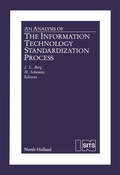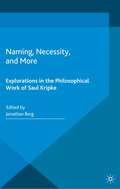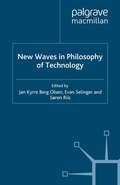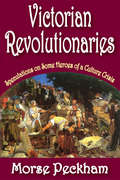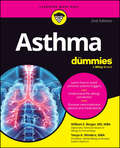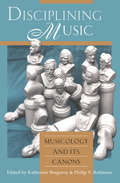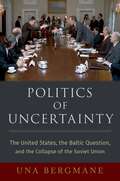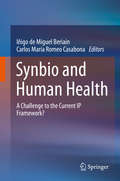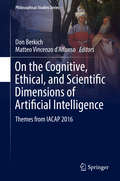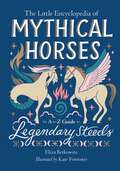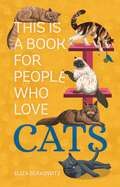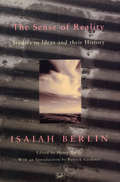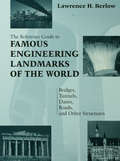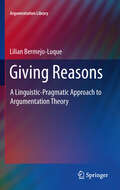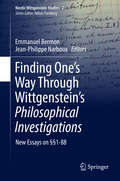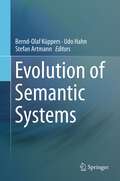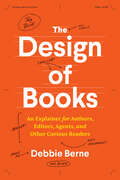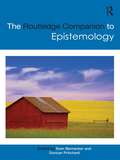- Table View
- List View
An Analysis of the Information Technology Standardization Process
by J. L. Berg H. SchumnyA number of important issues form the basis of this book: How can the Information Technology (IT) standardization process, leading to unified products which are needed on the market, be made more efficient? Which current IT standards are of high quality, what factors have led to that high quality, and can those factors be re-created for other IT standards? What improvements to the quality of IT standards are needed? Which organizations should be involved? What permanent changes in the IT standardization scene are necessary? At what point in the evolution of a technology is it appropriate to produce standards? Is strategic planning feasible in the current standardization approach? Diverse disciplines contributed to the findings in this book: computer scientists, standardization leaders and professionals, users and vendors, economists, auditors, software implementors, and communication specialists.
Naming, Necessity and More: Explorations in the Philosophical Work of Saul Kripke
by Jonathan BergSaul Kripke's Naming and Necessity was one of the most influential philosophical works of the twentieth century. In this collection of essays leading specialists explore issues arising from this and other works of Kripke's.
New Waves in Philosophy of Technology (New Waves in Philosophy)
by Jan Kyrre Berg OlsenThe volume advances research in the philosophy of technology by introducing contributors who have an acute sense of how to get beyond or reframe the epistemic, ontological and normative limitations that currently limit the fields of philosophy of technology and science and technology studies.
The Structural Links between Ecology, Evolution and Ethics: The Virtuous Epistemic Circle (Boston Studies in the Philosophy and History of Science)
by Donato BergandiEvolutionary biology, ecology and ethics: at first glance, three different objects of research, three different worldviews and three different scientific communities. In reality, there are both structural and historical links between these disciplines. First, some topics are obviously common across the board. Second, the emerging need for environmental policy management has gradually but radically changed the relationship between these disciplines. Over the last decades in particular, there has emerged a need for an interconnecting meta-paradigm that integrates more strictly evolutionary studies, biodiversity studies and the ethical frameworks that are most appropriate for allowing a lasting co-evolution between natural and social systems. Today such a need is more than a mere luxury, it is an epistemological and practical necessity.
Victorian Revolutionaries: Speculations on Some Heroes of a Culture Crisis
by Arthur Asa BergerThe Victorian era is rightly associated with the industrial revolution in Britain and the ascendancy of a materialist, commercially-oriented middle class. The threat to spiritual values was felt strongly in the realm of religion but also in the secular realm of the arts and literature. This volume analyzes the drive toward cultural transcendence in the lives and works of such eminent Victorians as Tennyson, Carlyle, Browning, the aesthetics of the Pre-Raphaelites, and the romantic origins of anthropology. The various modes of escape from the Victorian era helps illuminate present concerns about culture and society.First published in 1970, Victorian Revolutionaries represents a major effort in the intellectual rehabilitation of Victorian art and thought. Peckham's readings of In Memoriam and Idylls of the King show Tennyson at odds with Christianity except with the notion of the immortality of the soul. The terror of meaninglessness that he discerns here is echoed in the chapter on Carlyle who views human life as issuing from mystery and proceeding in chaos, protected only by self-deception. For Browning, the perceived lack of meaning or purpose results in an existential poetics of the world as theater and the individual as actor. Peckham's chapter on the Pre-Raphaelites anticipates their later rehabilitation by arguing that their work properly understood constitutes a challenge to the institutional modernism of the late twentieth century just as they had, in turn, challenged the academic values of the Royal Academy.The West is once more living in a culturally critical period today. Any help we can get in understanding how to deal with it is bound to be of value. Not the particular strategies of these men, but the general pattern of their search in social and anthropological theory is probably the most useful thing they have to offer.
Victorian Revolutionaries: Speculations on Some Heroes of a Culture Crisis
by Arthur Asa BergerThe Victorian era is rightly associated with the industrial revolution in Britain and the ascendancy of a materialist, commercially-oriented middle class. The threat to spiritual values was felt strongly in the realm of religion but also in the secular realm of the arts and literature. This volume analyzes the drive toward cultural transcendence in the lives and works of such eminent Victorians as Tennyson, Carlyle, Browning, the aesthetics of the Pre-Raphaelites, and the romantic origins of anthropology. The various modes of escape from the Victorian era helps illuminate present concerns about culture and society.First published in 1970, Victorian Revolutionaries represents a major effort in the intellectual rehabilitation of Victorian art and thought. Peckham's readings of In Memoriam and Idylls of the King show Tennyson at odds with Christianity except with the notion of the immortality of the soul. The terror of meaninglessness that he discerns here is echoed in the chapter on Carlyle who views human life as issuing from mystery and proceeding in chaos, protected only by self-deception. For Browning, the perceived lack of meaning or purpose results in an existential poetics of the world as theater and the individual as actor. Peckham's chapter on the Pre-Raphaelites anticipates their later rehabilitation by arguing that their work properly understood constitutes a challenge to the institutional modernism of the late twentieth century just as they had, in turn, challenged the academic values of the Royal Academy.The West is once more living in a culturally critical period today. Any help we can get in understanding how to deal with it is bound to be of value. Not the particular strategies of these men, but the general pattern of their search in social and anthropological theory is probably the most useful thing they have to offer.
Asthma For Dummies
by William E. Berger Tonya A. WindersBreathe easier and live a full life with proper asthma treatment Asthma For Dummies is a reassuring and realistic guide to managing asthma, whether you’re living with it yourself or have a loved one who suffers from the disease. It’s packed with authoritative information on symptoms and diagnosis, plus resources you can use to enhance long-term asthma management. Find the best treatments and reduce asthma complications with compassionate advice and all the latest details on medication options, including asthma controller drugs, rescue asthma medications, and future trends in asthma therapy. Discover the most common triggers and suggestions for avoiding them in daily life. With the expert advice in this Dummies guide, you can tackle asthma. Learn all the basics about diagnosing and managing asthma in adults and children Find out about the newest treatments, therapies, and alternative strategies Prepare for your doctor’s appointment with questions to ask and ideas for working through financial concerns Know what to do about complications, dual diagnoses, and special circumstancesThis updated edition of Asthma For Dummies is a must-have for asthmatics and parents of asthmatic children.
Asthma For Dummies
by William E. Berger Tonya A. WindersBreathe easier and live a full life with proper asthma treatment Asthma For Dummies is a reassuring and realistic guide to managing asthma, whether you’re living with it yourself or have a loved one who suffers from the disease. It’s packed with authoritative information on symptoms and diagnosis, plus resources you can use to enhance long-term asthma management. Find the best treatments and reduce asthma complications with compassionate advice and all the latest details on medication options, including asthma controller drugs, rescue asthma medications, and future trends in asthma therapy. Discover the most common triggers and suggestions for avoiding them in daily life. With the expert advice in this Dummies guide, you can tackle asthma. Learn all the basics about diagnosing and managing asthma in adults and children Find out about the newest treatments, therapies, and alternative strategies Prepare for your doctor’s appointment with questions to ask and ideas for working through financial concerns Know what to do about complications, dual diagnoses, and special circumstancesThis updated edition of Asthma For Dummies is a must-have for asthmatics and parents of asthmatic children.
Disciplining Music: Musicology and Its Canons
by Katherine Bergeron Philip V. BohlmanProvocative and timely, Disciplining Music confronts a topic that has sparked considerable debate in recent years: how do musicians and music scholars "discipline" music in their efforts to confer order and meaning on it? This collection of essays addresses this issue by formulating questions about music's canons—rules that measure and order, negotiate cultural constraints, reconstruct the past, and shape the future. Written by scholars representing the fields of historical musicology, ethnomusicology, and music theory, many of the essays tug and push at the very boundaries of these traditional division within the study of music. "Fortunately, in a blaze of good-humored . . . scholarship, [this] book helps brains unaccustomed to thinking about the future without jeopardizing the past imagine the wonder classical-music life might become if it embraced all people and all musics."—Laurence Vittes, Los Angeles Reader "These essays will force us to rethink our position on many issues. . . [and] advance musicology into the twenty-first century."—Giulio Ongaro, American Music Teacher With essays by Katherine Bergeron, Philip V. Bohlman, Richard Cohn and Douglas Dempster, Philip Gossett, Robert P. Morgan, Bruno Nettl, Don Michael Randel, Ruth A. Solie, and Gary Tomlinson.
The Recalcitrant Rich: A Comparative Analysis of the Northern Responses to the Demands for a New International Economic Order (Bloomsbury Academic Collections: Economics)
by Helge Ole Bergesen Hans-Henrik Holm Robert D. McKinlayThe Recalcitrant Rich is a collection of sharp and fairly short sketches and explanations of the responses to developing-country demands by seven West European countries, the European Community, the United States of America and the U.S.S.R. It aims to analyse the responses of the North to the demands from the South for those political and economic changes that collectively constitute the 'New International Economic Order' package.
Politics of Uncertainty: The United States, the Baltic Question, and the Collapse of the Soviet Union (OXFORD STUDIES IN INTL HISTORY SERIES)
by Una BergmaneIn March 1990, Lithuania became the first Soviet Republic to declare its independence. Within weeks, the two other Baltic states, Estonia and Latvia, announced the beginning of a transition period toward full sovereignty. The Soviet Union, which considered the Baltic declarations illegal, harshly condemned them and imposed an economic blockade against Lithuania. Fearing an outbreak of violence in the region, the United States tried to de-escalate the crisis, pressuring all sides to engage in dialogue. Thirty years after the Soviet collapse Politics of Uncertainty investigates the interplay between international and domestic dynamics in the Soviet disintegration process. Based on extensive multilingual archival research, this book recovers the voices of local actors in Riga, Tallinn, and Vilnius in its examination of the triangular relations between Washington, Moscow, and Baltic independence movements. Occupied and annexed by the USSR in 1940, Estonia, Latvia, and Lithuania were the first Soviet republics to push the limits of Perestroika. The Baltic problem, at first seemingly minor, increasingly gained international visibility and by 1990 risked derailing issues that mattered in the eyes of both Soviet and American leaders--the transformation of the Soviet state and transformation of the European order. The United States, which had never recognized the annexation of the Baltic states, tried to perform a highly challenging balancing act of supporting Baltic independence without jeopardizing relations with the Kremlin. Meanwhile Mikhail Gorbachev, who saw the Baltics as an integral part of the USSR, was frustrated that their secessionist tendencies distracted from the monumental opportunity for change that the Perestroika project offered to his country and the world. Meanwhile, George Bush, François Mitterrand, and Helmut Kohl were exasperated that events at the margins of the Soviet empire risked destabilizing Gorbachev and souring East-West relations during negotiations over German reunification. By focusing on the relations between those at the top of global power hierarchies and those situated at their margins, Una Bergmane underscores how the Soviet collapse was driven much more by uncertainty, domestic pressures, and last-minute decisions than by long-term strategy--while warning about the tenuous geopolitical positions of these three states that joined NATO and the European Union after breaking out of the Soviet empire.
Politics of Uncertainty: The United States, the Baltic Question, and the Collapse of the Soviet Union (OXFORD STUDIES IN INTL HISTORY SERIES)
by Una BergmaneIn March 1990, Lithuania became the first Soviet Republic to declare its independence. Within weeks, the two other Baltic states, Estonia and Latvia, announced the beginning of a transition period toward full sovereignty. The Soviet Union, which considered the Baltic declarations illegal, harshly condemned them and imposed an economic blockade against Lithuania. Fearing an outbreak of violence in the region, the United States tried to de-escalate the crisis, pressuring all sides to engage in dialogue. Thirty years after the Soviet collapse Politics of Uncertainty investigates the interplay between international and domestic dynamics in the Soviet disintegration process. Based on extensive multilingual archival research, this book recovers the voices of local actors in Riga, Tallinn, and Vilnius in its examination of the triangular relations between Washington, Moscow, and Baltic independence movements. Occupied and annexed by the USSR in 1940, Estonia, Latvia, and Lithuania were the first Soviet republics to push the limits of Perestroika. The Baltic problem, at first seemingly minor, increasingly gained international visibility and by 1990 risked derailing issues that mattered in the eyes of both Soviet and American leaders--the transformation of the Soviet state and transformation of the European order. The United States, which had never recognized the annexation of the Baltic states, tried to perform a highly challenging balancing act of supporting Baltic independence without jeopardizing relations with the Kremlin. Meanwhile Mikhail Gorbachev, who saw the Baltics as an integral part of the USSR, was frustrated that their secessionist tendencies distracted from the monumental opportunity for change that the Perestroika project offered to his country and the world. Meanwhile, George Bush, François Mitterrand, and Helmut Kohl were exasperated that events at the margins of the Soviet empire risked destabilizing Gorbachev and souring East-West relations during negotiations over German reunification. By focusing on the relations between those at the top of global power hierarchies and those situated at their margins, Una Bergmane underscores how the Soviet collapse was driven much more by uncertainty, domestic pressures, and last-minute decisions than by long-term strategy--while warning about the tenuous geopolitical positions of these three states that joined NATO and the European Union after breaking out of the Soviet empire.
Synbio and Human Health: A Challenge to the Current IP Framework?
by Iñigo Miguel Beriain Carlos María Romeo CasabonaSince 2010, the Inter-university chair in law and the Human Genome has been involved in an EU 7th Framework Programme funded Project called Sybhel, leading work package 5. The aim of this work package was to face the issues related to synthetic biology and intellectual property rights. In these years, the Chair organized two international workshops devoted to this topic, collecting a number of high level unpublished papers redacted by some of the most prominent experts in this field worldwide, including Stephen Maurer, Joachim Henkel, Ingrid Schneider, etc. We consider that it would be extremely interesting to have them all gathered in a unique contributed volume, which would be the first book exclusively dedicated to analyze the implications that Synbio may involve in what refers to the currently existing intellectual property rights system.
On the Cognitive, Ethical, and Scientific Dimensions of Artificial Intelligence: Themes from IACAP 2016 (Philosophical Studies Series #134)
by Don Berkich Matteo Vincenzo D'AlfonsoThis edited volume explores the intersection between philosophy and computing. It features work presented at the 2016 annual meeting of the International Association for Computing and Philosophy. The 23 contributions to this volume neatly represent a cross section of 40 papers, four keynote addresses, and eight symposia as they cut across six distinct research agendas. The volume begins with foundational studies in computation and information, epistemology and philosophy of science, and logic. The contributions next examine research into computational aspects of cognition and philosophy of mind. This leads to a look at moral dimensions of man-machine interaction as well as issues of trust, privacy, and justice. This multi-disciplinary or, better yet, a-disciplinary investigation reveals the fruitfulness of erasing distinctions among and boundaries between established academic disciplines. This should come as no surprise. The computational turn itself is a-disciplinary and no former discipline, whether scientific, artistic, or humanistic, has remained unchanged. Rigorous reflection on the nature of these changes opens the door to inquiry into the nature of the world, what constitutes our knowledge of it, and our understanding of our place in it. These investigations are only just beginning. The contributions to this volume make this clear: many encourage further research and end with open questions.
The Little Encyclopedia of Mythical Horses: An A-to-Z Guide to Legendary Steeds (The Little Encyclopedias of Mythological Creatures)
by Eliza BerkowitzFrom Arthurian legend to tales of ancient China, horses have traversed the world alongside humans for centuries, and their heroic adventures are gathered here in this one-of-a-kind little encyclopedia . . . Beloved for their grace, strength, and untamed beauty, horses have always loomed large in our imaginations, featuring in mythologies across cultures and throughout history. This little encyclopedia rounds up more than 50 mythical horses from around the world, including: Bai Long Ma, part dragon and part horse, of the Chinese classic Journey to the West Balius and Xanthus, Achilles's horses who fought in the Trojan War Pegasus, a winged stallion and child of the Greek god Poseidon Sleipnir, a war horse belonging to great Norse god Odin And so many more! With detailed illustrations throughout, this book pays tribute to some of our most formidable equine friends.
This Is a Book for People Who Love Cats (This Is a Book for People Who Love)
by Eliza BerkowitzFull of feline facts, lessons translating cat behavior, and illustrated breed profiles, This Is a Book for People Who Love Cats is a joyful celebration of all nine lives of cat friends! For cat lovers of all ages, this beautifully illustrated guide offers an informative look at the world and lives of cats. Cat enthusiast Eliza Berkowitz highlights why we love cats so much, how cats became domesticated, and just what they're doing and saying with their odd behavior. Fascinating profiles of cat breeds, from Maine Coons and Calicos to Bengals and Egyptian Maus, are accompanied by charming illustrations that will make you fall in love with cats all over again... and again. Comprehensively researched and shared in an accessible, appealing format, This Is a Book for People Who Love Cats is a purr-fect addition to every cat lover's library.
The Sense Of Reality: Studies in Ideas and their History (Pensamiento Ser.)
by Isaiah BerlinEight of the nine pieces in The Sense of Reality are published here for the first time. The range is characteristically wide: realism in history; judgement in politics; the special right of philosophers to self-expression; the history of socialism; the nature and impact of Marxism; the radical cultural revolution instigated by romanticism; the Russian notion of artistic commitment; the origins and practice of nationalism. The title essay, starting from the impossibility of recreating a bygone epoch, provides a superb centrepiece.
Reference Guide to Famous Engineering Landmarks of the World: Bridges, Tunnels, Dams, Roads and Other Structures
by Lawrence BerlowMore than 650 landmarks are covered, ranging from ancient monuments such as Stonehenge, to contemporary engineering feats such as the World Trade Center in New York City. The concisely-written entries describe when the landmark was built, who built it, why it was built, its dimensions, how it was constructed, and any problems encountered during construction. Additional features include: numerous photographs; biographies of important builders and designers; glossary; chronology of dates in civil engineering from 3000 BC to the present; listings of tallest buildings, longest bridges, and highest dams, and a geographical index which locates the structures by country.
Reference Guide to Famous Engineering Landmarks of the World: Bridges, Tunnels, Dams, Roads and Other Structures
by Lawrence BerlowMore than 650 landmarks are covered, ranging from ancient monuments such as Stonehenge, to contemporary engineering feats such as the World Trade Center in New York City. The concisely-written entries describe when the landmark was built, who built it, why it was built, its dimensions, how it was constructed, and any problems encountered during construction. Additional features include: numerous photographs; biographies of important builders and designers; glossary; chronology of dates in civil engineering from 3000 BC to the present; listings of tallest buildings, longest bridges, and highest dams, and a geographical index which locates the structures by country.
Giving Reasons: A Linguistic-Pragmatic Approach to Argumentation Theory (Argumentation Library #20)
by Lilian Bermejo LuqueThis book provides a new, linguistic approach to Argumentation Theory. Its main goal is to integrate the logical, dialectical and rhetorical dimensions of argumentation in a model providing a unitary treatment of its justificatory and persuasive powers. This model takes as its basis Speech Acts Theory in order to characterize argumentation as a second-order speech act complex. The result is a systematic and comprehensive theory of the interpretation, analysis and evaluation of arguments. This theory sheds light on the many faces of argumentative communication: verbal and non-verbal, monological and dialogical, literal and non-literal, ordinary and specialized.The book takes into consideration the major current comprehensive accounts of good argumentation (Perelman’s New Rhetoric, Pragma-dialectics, the ARG model, the Epistemic Approach) and shows that these accounts have fundamental weaknesses rooted in their instrumentalist conception of argumentation as an activity oriented to a goal external to itself. Furthermore, the author addresses some challenging meta-theoretical questions such as the justification problem for Argumentation Theory models and the relationship between reasoning and arguing.
Finding One’s Way Through Wittgenstein’s Philosophical Investigations: New Essays on §§1-88 (Nordic Wittgenstein Studies #2)
by Emmanuel Bermon Jean-Philippe NarbouxThis volume sheds a new light on Philosophical Investigations, Ludwig Wittgenstein’s master opus, by taking a new approach to its first stretch (sections §§1-88), with special emphasis on its atypical opening. The methodological conviction that subtends the volume is that the highly unconventional form assumed by the book is internal to its content and crucial to its reconception of the relation between logic and language. This disconcerting form is dictated by the new modes of criticism deployed by Wittgenstein as he engages the philosophical tradition in the new terms afforded by the revolutionary “method of language-games”. In the essays collected here, seven authors, including some of the most influential figures in the field, offer close and often unorthodox readings of pivotal passages from the beginning of the book. These readings are also shaped by the conviction that the Philosophical Investigations are hardly intelligible apart from an appreciation of the concerns that they inherit from Wittgenstein’s early work, the Tractatus Logico-Philosophicus. The authors contend that we need to consider the continuities between the early and the later works if we are to disclose the true discontinuities between them.
Evolution of Semantic Systems
by Bernd-Olaf Küppers, Udo Hahn and Stefan ArtmannComplex systems in nature and society make use of information for the development of their internal organization and the control of their functional mechanisms. Alongside technical aspects of storing, transmitting and processing information, the various semantic aspects of information, such as meaning, sense, reference and function, play a decisive part in the analysis of such systems.With the aim of fostering a better understanding of semantic systems from an evolutionary and multidisciplinary perspective, this volume collects contributions by philosophers and natural scientists, linguists, information and computer scientists. They do not follow a single research paradigm; rather they shed, in a complementary way, new light upon some of the most important aspects of the evolution of semantic systems.Evolution of Semantic Systems is intended for researchers in philosophy, computer science, and the natural sciences who work on the analysis or development of semantic systems, ontologies, or similar complex information structures. In the eleven chapters, they will find a broad discussion of topics ranging from underlying universal principles to representation and processing aspects to paradigmatic examples.
The Design of Books: An Explainer for Authors, Editors, Agents, and Other Curious Readers (Chicago Guides to Writing, Editing, and Publishing)
by Debbie BerneSeasoned designer Debbie Berne presents an accessible introduction to book design for authors, editors, and other book people. Design is central to the appeal, messaging, and usefulness of books, but to most readers, it’s mysterious or even invisible. Through interiors as well as covers, designers provide structure and information that shape the meaning and experience of books. In The Design of Books, Debbie Berne shines a light on the conventions and processes of her profession, revealing both the aesthetic and market-driven decisions designers consider to make books readable and beautiful. In clear, unstuffy language, Berne reveals how books are put together, with discussions of production considerations, typography and fonts, page layouts, use of images and color, special issues for ebooks, and the very face of each book: the cover. The Design of Books speaks to readers and directly to books’ creators—authors, editors, and other publishing professionals—helping them to become more informed partners in the design of their projects. Berne lays out the practical steps at each stage of the design process, providing insight into who does what when and offering advice for authors on how to be effective advocates for their ideas while also letting go and trusting their manuscripts with teams of professionals. She includes guidance as well for self-publishing authors, including where to find a designer, what to expect from that relationship, and how to art direct your own book. Throughout, Berne teaches how understanding the whats, hows, and whys of book design heightens our appreciation of these cherished objects and helps everyone involved in the process to create more functional, desirable, and wonderful books.
The Routledge Companion to Epistemology (Routledge Philosophy Companions)
by Sven Bernecker Duncan PritchardEpistemology, the philosophy of knowledge, is at the core of many of the central debates and issues in philosophy, interrogating the notions of truth, objectivity, trust, belief and perception. The Routledge Companion to Epistemology provides a comprehensive and the up-to-date survey of epistemology, charting its history, providing a thorough account of its key thinkers and movements, and addressing enduring questions and contemporary research in the field. Organized thematically, the Companion is divided into ten sections: Foundational Issues, The Analysis of Knowledge, The Structure of Knowledge, Kinds of Knowledge, Skepticism, Responses to Skepticism, Knowledge and Knowledge Attributions, Formal Epistemology, The History of Epistemology, and Metaepistemological Issues. Seventy-eight chapters, each between 5000 and 7000 words and written by the world’s leading epistemologists, provide students with an outstanding and accessible guide to the field. Designed to fit the most comprehensive syllabus in the discipline, this text will be an indispensible resource for anyone interested in this central area of philosophy. The Routledge Companion to Epistemology is essential reading for students of philosophy.
The Routledge Companion to Epistemology (Routledge Philosophy Companions)
by Sven Bernecker Duncan PritchardEpistemology, the philosophy of knowledge, is at the core of many of the central debates and issues in philosophy, interrogating the notions of truth, objectivity, trust, belief and perception. The Routledge Companion to Epistemology provides a comprehensive and the up-to-date survey of epistemology, charting its history, providing a thorough account of its key thinkers and movements, and addressing enduring questions and contemporary research in the field. Organized thematically, the Companion is divided into ten sections: Foundational Issues, The Analysis of Knowledge, The Structure of Knowledge, Kinds of Knowledge, Skepticism, Responses to Skepticism, Knowledge and Knowledge Attributions, Formal Epistemology, The History of Epistemology, and Metaepistemological Issues. Seventy-eight chapters, each between 5000 and 7000 words and written by the world’s leading epistemologists, provide students with an outstanding and accessible guide to the field. Designed to fit the most comprehensive syllabus in the discipline, this text will be an indispensible resource for anyone interested in this central area of philosophy. The Routledge Companion to Epistemology is essential reading for students of philosophy.
